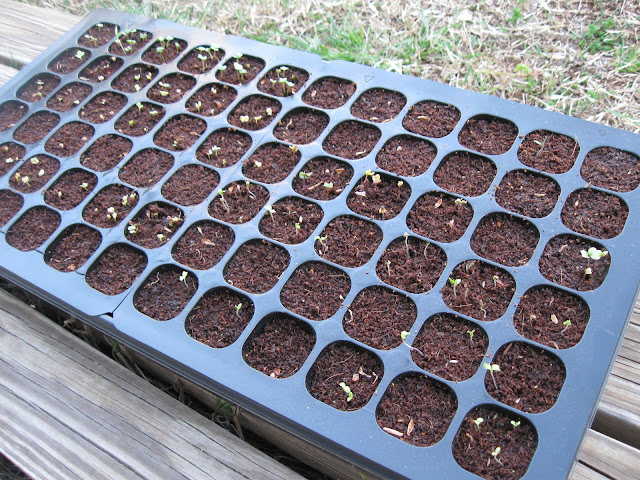I try to start peppers and eggplants so they are 12 weeks old by the time they're planted outside, but it can take a few weeks for their seeds to germinate. Tomatoes sprout out of the soil and grow fairly quickly so they are started 8 weeks before planting time.
The easiest way to start seeds indoors is by using a seed starting tray which can be a single or multi-celled tray with a light fluffy seed starting medium that allows the plants to easily sprout out of. Some gardeners use a tray without any subdivided cells and just plant lots of a single variety of vegetable or they plant different varieties in rows and label them, and then the seedlings are pricked out and deposited into larger individual containers.
Personally, I use a multi-celled tray. For germinating peppers and eggplants the seed tray is placed in a fairly warm area or where they will at least get consistently warm bottom heat, perhaps on top of the refrigerator or water-heater. The last 2 years I have been using pelletized coconut coir as a seed starting medium which is made from fibrous coconut husk and is light and fluffy, so makes for easy germination. The notable aspect of coconut coir is that it's a non-nutritive medium, meaning it will provide little nutrition to your growing plants so once sprouted the plants will need to be potted up in potting soil or compost in their own individual containers. The cotyledons or seed leaves will be the first set of leaves to emerge.
 |
| Tray of sprouting seedlings. |
Then the newly potted up seedlings are placed in a sunny window or under lights. I try to get the lights as close to the plants as possible without touching them which will help them from getting too leggy as they try to reach for the lights. Some gardeners carefully run their hand across the top of the plants or have a weak fan running to promote stronger stems. Once the first set of true leaves start developing many people begin to feed the seedlings a watered down fish emulsion or some light liquid fertilizer on a weekly basis, I usually forget and feed the plants when they're a bit bigger.
 |
| Tomatoes, peppers, and eggplants under lights. |
A note on potting soil. Usually I repot the plants in potting soil containing compost, but some of the plants this year got repotted in a peat moss based medium. The ones in peat moss are not doing as well as the other plants, and most of their cotyledon leaves have turned brown and fallen off. Peat moss is notoriously acidic which makes me wonder if this affects the growth of the plants, plus I'm not sure how nutritious that sort of soil medium is.
 |
| Kellogg's Breakfast tomato in peat moss based soil medium. |
The warm weather plants like tomatoes, peppers, and eggplants can start being hardened off outside when the daytime temperatures reach the 60's (16 Celsius). Let the young seedlings get a few hours of outdoor sunlight each day in a warm sheltered spot, it's best for the first couple days to be partly cloudy so the plants don't get traumatized and perhaps suffer leaf burn from the strong sunlight.
Once the last frost date has passed and the nighttime temperatures are consistently in the 50's (10 Celsius), the seedlings can be planted into the soil in the prepared garden area. I try to rototill the area for the garden a week before planting time, which will give the sun a chance to warm up the newly tilled soil. Hopefully by planting time the daytime temps are in the 70's (21 Celsius).
 |
| Moneymaker tomato getting some sunshine. |
 |
| Bangladeshi Long eggplant you can see the difference between the cotyledon seed leaves and true leaves. |































